Infrared therapy can dramatically speed up healing of your chronic wounds through deep tissue penetration. You'll benefit from improved blood flow, reduced inflammation, and accelerated tissue repair as the infrared light stimulates your cells to produce more ATP energy. The therapy breaks apart blood clusters to deliver essential nutrients and oxygen to your wound site more efficiently, while triggering nitric oxide release for natural pain relief. Clinical studies show this treatment can cut healing time by up to 50% compared to traditional methods alone. Learn how this powerful therapy could transform your wound recovery journey.
Understanding Chronic Wounds
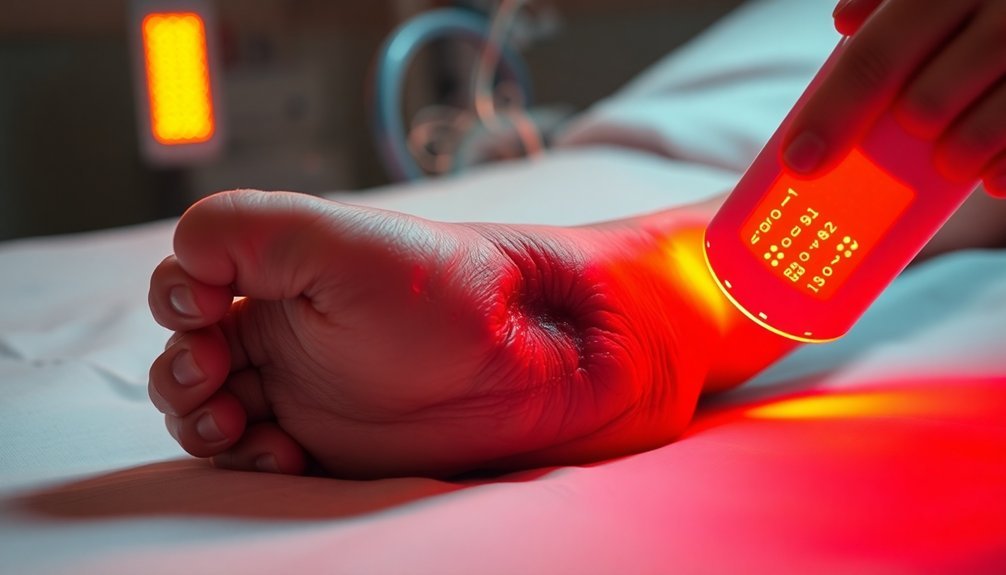
Managing chronic wounds requires understanding their fundamental nature and complexity. A chronic wound is damaged tissue that fails to heal within expected timeframes, and you'll find these injuries commonly occurring in the lower legs, feet, and ankles. These wounds often stay in an inflammatory phase for extended periods without progressing to healing.
You should be aware of several risk factors that contribute to chronic wounds. If you're elderly, diabetic, or dealing with obesity, you're at higher risk.
Poor circulation, malnutrition, and lifestyle choices like smoking can substantially impact your wound healing ability. The presence of underlying health conditions, particularly those affecting your immune system or blood supply, can further complicate the healing process.
When you're dealing with a chronic wound, you'll likely experience symptoms such as pain, swelling, and inflammation. You might notice bleeding, blistering, or darkened skin around the wound site. If you develop fever or see pus, these could indicate an infection.
Healthcare providers will typically conduct lab tests to check for infections, autoimmune disorders, and other systemic conditions that might be preventing proper healing. Treatment often involves a thorough approach, including specialized wound care, nutritional support, and management of underlying conditions.
The Science Behind Infrared Therapy
While chronic wounds pose significant challenges, modern treatment options like infrared therapy offer promising solutions based on compelling scientific principles.
When you receive infrared therapy, light waves longer than visible light penetrate deep into your body's tissues – reaching depths of 2 to 7 centimeters to affect muscles, nerves, and bones.
The science behind this treatment is remarkably precise. As infrared light enters your tissues, it triggers a series of metabolic events at the cellular level. Your cells convert this light energy into cellular energy, stimulating mitochondria to produce more ATP, which is essential for healing. During this process, tissue regeneration and repair is accelerated through enhanced cell proliferation.
You'll also experience increased nitric oxide production, which relaxes your arteries and helps regulate blood pressure.
Through a process called photobiomodulation, infrared therapy positively influences your body's biochemical responses. The most effective wavelengths for wound healing fall between 800-830 nm in the near-infrared spectrum.
This technology works by enhancing blood circulation, stimulating collagen production, and reducing inflammation. As your blood flow improves, more oxygen and nutrients reach the wounded area, accelerating the healing process while naturally managing pain through increased endorphin production.
Benefits for Wound Recovery
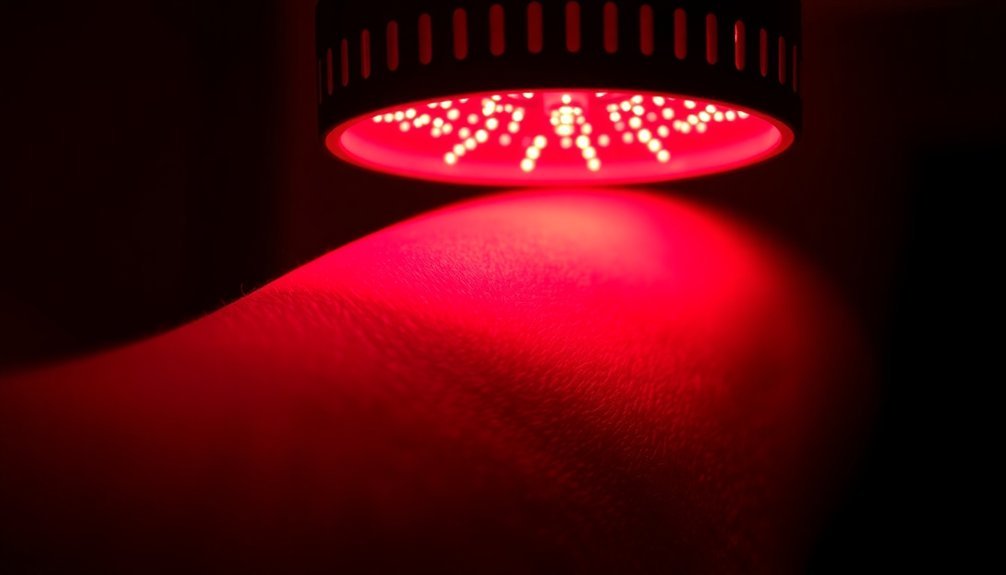
Numerous clinical studies have demonstrated the remarkable benefits of infrared therapy for chronic wound recovery. You'll experience faster healing times as this therapy accelerates tissue regeneration and promotes blood flow to the wound site.
When infrared penetrates your skin, it stimulates collagen synthesis and enhances tissue remodeling, turning weeks of healing into days. Studies using laser Doppler imaging show that blood perfusion increases significantly after infrared treatment.
If you're dealing with pain from chronic wounds, you'll find that infrared therapy provides significant relief. It works by causing local vasodilation and releasing natural pain-relieving compounds like endorphins. The therapy's deep penetration helps improve your sensory nerve conduction and reduces discomfort during the healing process.
You'll benefit from infrared therapy's powerful anti-inflammatory effects. It actively reduces chronic inflammation by removing waste products from your wound site and suppresses oxidative stress.
For diabetic wounds, it's particularly effective as it decreases inflammatory responses and enhances tissue perfusion. The therapy also boosts angiogenesis, creating new blood vessels in the wound area, which is essential for proper healing. Your body's natural repair mechanisms are enhanced through increased expression of growth factors like VEGF and EGF.
Different Types of Wound Treatment
When treating wounds, you'll find treatment methods generally fall into direct approaches like surgical debridement and indirect methods such as infrared therapy.
Multiple layer bandages can be used for compression therapy to improve circulation and promote healing in wounds affecting the lower extremities.
Modern wound care has evolved to include advanced technologies that range from negative pressure systems to specialized dressings that actively promote healing.
These varied treatment options let you and your healthcare provider choose the most effective approach based on your wound type, severity, and healing goals.
Direct vs. Indirect Methods
As medical professionals explore various approaches to wound treatment, infrared therapy has emerged with two distinct methodologies: direct and indirect application. Direct application involves targeting the wound site specifically, where infrared light directly penetrates the affected tissue to stimulate healing processes, enhance blood flow, and promote cellular repair. The therapy particularly excels at breaking apart water clusters in blood plasma to improve circulation.
| Aspect | Direct Method | Indirect Method |
|---|---|---|
| Application | Applied directly to wound site | Targeted at remote areas |
| Primary Benefits | Immediate local healing response | Systemic healing effects |
| Best Used For | Surface wounds, localized damage | Deep tissue, chronic conditions |
You'll find that direct methods excel at promoting local healing through increased collagen synthesis, enhanced blood perfusion, and accelerated tissue repair. When the infrared light directly contacts your wound, it triggers immediate responses like reduced inflammation and increased cellular proliferation.
Indirect methods, while less concentrated, offer systemic benefits that can support overall healing. You don't need direct contact with the wound site to experience the anti-inflammatory effects and improved circulation. This approach works particularly well when targeting deeper tissues or when direct access to the wound isn't practical.
Advanced Treatment Technologies
The landscape of wound treatment has expanded dramatically with innovative technologies that offer new hope for chronic wound sufferers.
Negative-pressure wound therapy (NPWT) uses computerized suction pumps to apply sub-atmospheric pressure, removing harmful fluids while promoting blood flow and tissue formation. These systems help cleanse and draw fluids from wounds to prevent infection.
Advanced dressings now come infused with growth factors and antimicrobial agents, while hydrogel variants can intelligently absorb or release liquid as needed.
For more severe cases, you've got options like skin substitutes, which can be either biologic or synthetic, introducing living cells to stimulate repair.
Extracellular matrix (ECM) therapies provide natural scaffolding that recruits stem cells for tissue repair.
When you're dealing with dead tissue, debridement using tools like the Misonix SonicOne Plus creates an ideal healing environment with minimal blood loss.
Stem cell therapies, derived from adipose tissue or bone marrow, offer promising results for non-healing wounds.
You can also benefit from infrared therapy, which uses far-infrared light to accelerate cell growth and improve blood flow, requiring less than an hour of daily treatment for significant benefits.
Clinical Research and Evidence
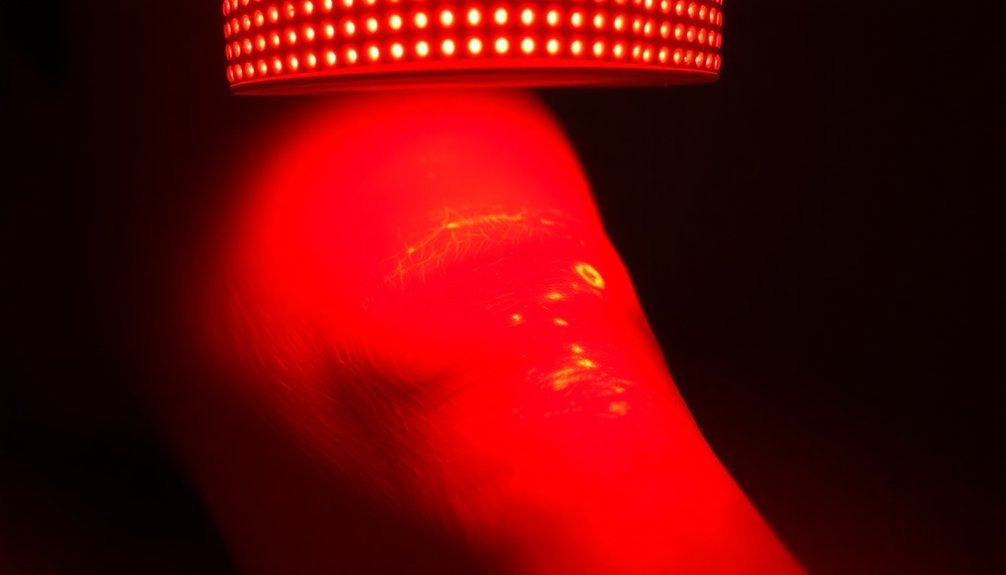
Clinical research shows you'll see faster healing when using far infrared therapy, with studies revealing up to 50% reduction in wound healing time compared to conventional treatments.
Red light therapy significantly reduces inflammation while promoting the production of anti-inflammatory cytokines, creating optimal conditions for tissue repair.
You'll notice measurable pain reduction during and after FIR treatments, backed by multiple controlled trials measuring patient responses.
Blood flow studies confirm that FIR therapy substantially increases circulation to wound sites, with researchers documenting enhanced angiogenesis and improved oxygen delivery to damaged tissues.
Research Confirms Healing Speed
Research consistently validates the healing benefits of far infrared (FIR) therapy for chronic wounds, with multiple studies demonstrating significant reductions in recovery time.
A recent clinical trial showed that patients receiving FIR therapy experienced significantly lower BWAT scores compared to those receiving only conventional wound care.
FIR therapy accelerates wound healing through multiple mechanisms, particularly by enhancing blood flow and promoting tissue regeneration.
When you use FIR therapy, you're benefiting from improved microcirculation as it expands small blood vessels and increases oxygen delivery to the wound site. This enhanced blood flow guarantees your wound receives essential nutrients more efficiently, while promoting the formation of new blood vessels through angiogenesis.
You'll experience reduced inflammation during the healing process, as FIR therapy helps suppress early inflammatory responses and decreases inflammatory markers. This reduction in inflammation, combined with decreased oxidative stress, creates a favorable environment for your wound to heal.
The therapy also strengthens your healing tissue by boosting collagen production and accelerating epithelialization. You'll notice faster wound closure and improved durability of the healed tissue.
Clinical studies confirm that FIR-treated wounds demonstrate superior strength and flexibility, reducing your risk of re-injury while promoting complete recovery.
Evidence-Based Pain Reduction
Compelling evidence from multiple clinical trials demonstrates that far infrared therapy substantially reduces pain in chronic wound patients. The therapy works by triggering nitric oxide production and stimulating natural endorphin release in your body, creating a powerful pain-relieving effect while simultaneously promoting healing.
| Pain Relief Mechanism | Clinical Benefit |
|---|---|
| Nitric Oxide Release | Relaxes blood vessels and improves circulation |
| Endorphin Production | Natural pain reduction and comfort |
| Reduced Inflammation | Less pressure and swelling around wound site |
| Enhanced Blood Flow | Better nutrient delivery to affected areas |
You'll experience multiple therapeutic benefits as FIR therapy penetrates deep into your tissue. The treatment improves microcirculation by expanding blood vessels, which helps deliver essential nutrients to your wound site while removing inflammatory compounds. Research confirms it's particularly effective for chronic conditions like osteoarthritis and persistent lower back pain associated with wounds. Clinical studies have documented significant reductions in healing time and pain levels when patients receive consistent FIR therapy. The treatment's safety profile is excellent, though you should avoid it if you have impaired thermal sensations or photosensitivity conditions.
Blood Flow Study Results
A landmark series of clinical studies has revealed dramatic improvements in blood flow among chronic wound patients receiving far infrared (FIR) therapy. When you're treated with FIR, your blood vessels dilate, allowing enhanced oxygen and nutrient delivery to wound sites.
Research shows this vasodilation effect particularly benefits the smallest blood vessels, improving microcirculation where it's needed most.
The evidence is compelling: FIR therapy substantially increases blood perfusion in wound areas while simultaneously reducing wound size. You'll find this especially important if you're dealing with diabetic wounds, where blood flow is often compromised.
Studies demonstrate that FIR therapy triggers a cascade of healing responses, including accelerated cellular proliferation and enhanced collagen synthesis.
What's particularly remarkable is how FIR therapy promotes angiogenesis – the formation of new blood vessels. This means you're not just getting better blood flow through existing vessels; you're actually developing new pathways for healing.
The research confirms that this improved vascularization leads to stronger tissue repair, better wound closure, and reduced healing times. These benefits are consistently documented across multiple clinical trials, making FIR therapy a proven method for enhancing wound-related blood flow.
Applying Infrared Therapy at Home
Infrared therapy devices have made professional-grade wound treatment accessible from the comfort of your home. To guarantee effective treatment, you'll need to follow specific guidelines and use the right equipment. Whether you're using specialized FIR devices or red light therapy tools, proper positioning and consistent application are essential for optimal results.
Before starting treatment, thoroughly clean your device according to the manufacturer's instructions to prevent infection. Position the device directly over your wound, ensuring proper skin contact.
You shouldn't exceed the recommended treatment time, which is typically less than an hour per day. While using infrared therapy, regularly monitor your wound's progress to determine if adjustments are needed.
You can choose from various devices, including specialized FIR units that convert body heat into far infrared energy or red light therapy devices that deliver concentrated natural light wavelengths. Both options are safe, non-invasive, and can effectively accelerate wound healing while reducing inflammation.
If you're managing chronic or diabetic wounds, you'll find infrared therapy particularly beneficial. Remember that you can combine this treatment with traditional wound care methods for enhanced healing outcomes.
Regular wound assessments will help you track progress and adjust your treatment plan accordingly.
Future Developments in Wound Care
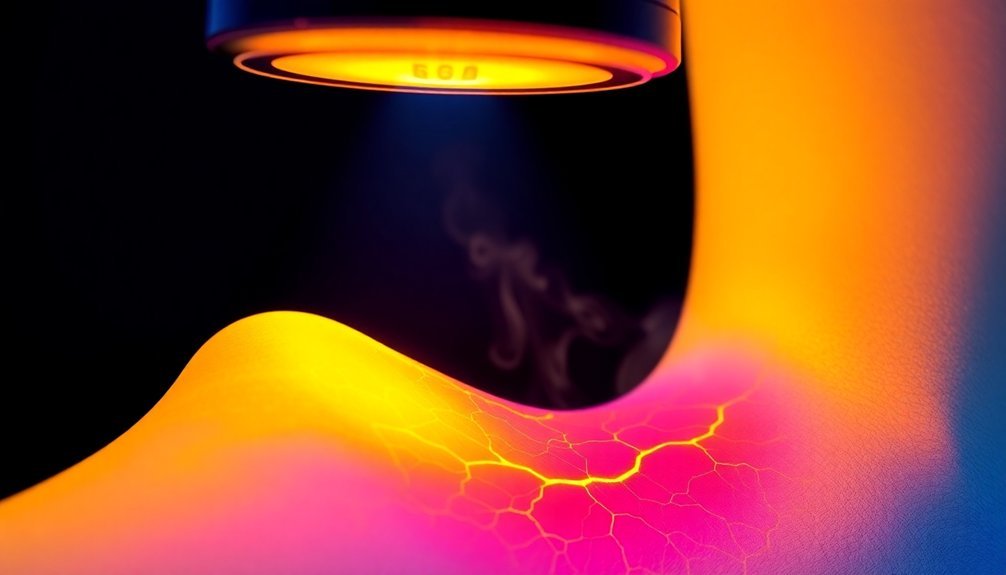
Revolutionary breakthroughs in wound care technology are transforming how we treat and manage chronic wounds. You'll soon see smart bandages that can monitor your wound's condition and communicate with your smartphone, alerting you and your healthcare provider to any complications.
These innovations combine with AI and machine learning to deliver personalized treatment plans based on your specific wound characteristics and genetic factors.
The integration of advanced technologies is creating a new standard in wound care through:
- Smart sensors that provide real-time monitoring of temperature, oxygen levels, and moisture
- Nanomaterials that enhance healing and prevent infection using zinc oxide, silver, or gold
- 3D imaging systems that precisely track wound progress and adjust treatment accordingly
You can expect to see more developments in infrared therapy, particularly with portable devices that convert your body heat into healing far-infrared energy. These devices will work alongside bioengineered skin substitutes and AI-driven treatment protocols to accelerate healing times and improve outcomes.
With the wound care market growing steadily, you'll have access to increasingly sophisticated tools that combine infrared technology with smart monitoring systems for better wound management.
Frequently Asked Questions
Can Infrared Therapy Be Used Alongside Other Wound Treatments?
Yes, you can safely combine infrared therapy with other wound treatments. It's often used alongside antibiotics, dressings, and compression therapy to enhance healing results and reduce inflammation in your treatment plan.
How Soon After Injury Should Infrared Therapy Treatment Begin?
You'll get the best results by starting infrared therapy immediately after injury. If you have a chronic wound, you can begin treatment at any time – it's never too late to benefit from this therapy.
Are There Any Side Effects of Using Infrared Therapy?
You'll need to be careful with infrared therapy as it can cause problems if you have certain conditions like skin sensitivity, metal implants, or tuberculosis. Overuse can also activate harmful pathways in your body.
What Is the Average Cost of Infrared Therapy for Wound Treatment?
You'll find infrared therapy costs vary widely. You can expect to pay $50-$200 per professional session, or invest in a home device for $100-$500. Insurance may cover some costs if prescribed.
Is Infrared Therapy Covered by Insurance for Chronic Wound Treatment?
Your insurance may cover infrared therapy for chronic wounds if it's deemed medically necessary. Coverage varies by provider, and you'll likely need pre-authorization and a prescription from your healthcare provider for approval.
In Summary
Infrared therapy offers you a promising treatment option for chronic wounds. You'll find its ability to boost circulation, reduce inflammation, and stimulate cellular repair particularly beneficial. While it's not a standalone solution, you can use it alongside traditional treatments for better results. Keep in mind that proper medical guidance is essential, and you should monitor your progress carefully when incorporating infrared therapy into your wound care routine.

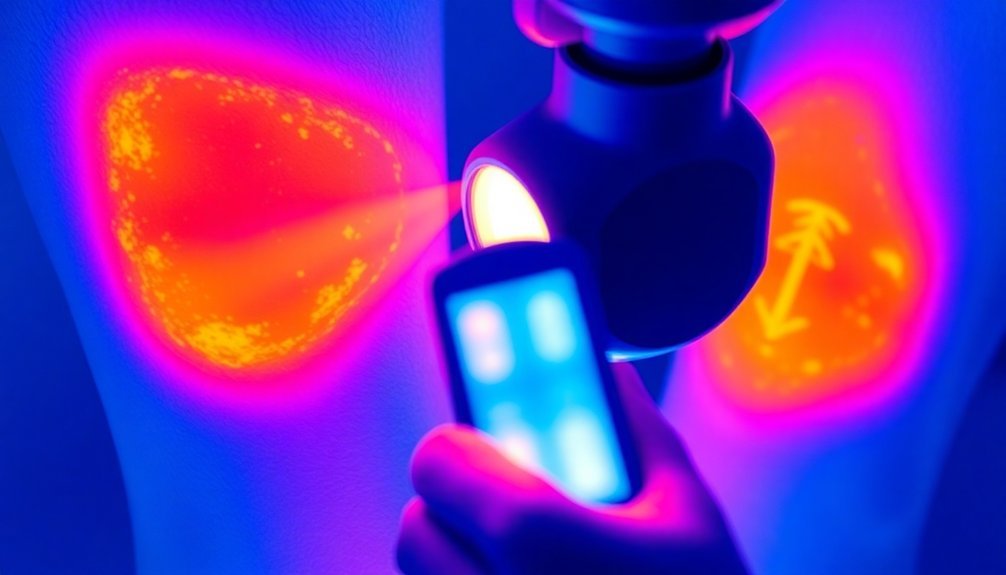



Leave a Reply